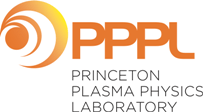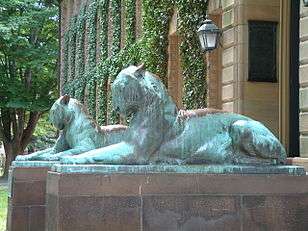Princeton Plasma Physics Laboratory
 | |
| Established | 1961 |
|---|---|
| Budget | $75 million (2012)[1] |
Field of research | Plasma physics |
| Vice-President | David J. McComas, Vice-President for PPPL |
| Director | Dr. Terrence K. Brog (interim) [2] |
| Address | 100 Stellarator Road, Princeton New Jersey |
| Location |
Plainsboro Township, New Jersey, United States 40°20′56″N 74°36′08″W / 40.348825°N 74.602183°WCoordinates: 40°20′56″N 74°36′08″W / 40.348825°N 74.602183°W |
Zip code | 08536 |
| Campus | Forrestal Campus |
Operating agency | Princeton University |
| Website |
www |
Princeton Plasma Physics Laboratory (PPPL) is a United States Department of Energy national laboratory for plasma physics and nuclear fusion science located on Princeton University's Forrestal Campus in Plainsboro Township, Middlesex County, New Jersey, United States, though with a Princeton address. Its primary mission is research into and development of fusion as an energy source. It grew out of the top secret Cold War project to control thermonuclear reactions, called Project Matterhorn. In 1961, after declassification, Project Matterhorn was renamed the Princeton Plasma Physics Laboratory.[3]
History
Lyman Spitzer, Jr., a professor of Astronomy at Princeton University, had for many years been involved in the study of very hot rarefied gases in interstellar space. He was inspired by the fascinating, but erroneous claims of controlled nuclear fusion achieved in Argentina by Ronald Richter, Spitzer.[4] In 1950, he conceived of a plasma being confined in a figure-eight-shaped tube by an externally generated magnetic field, where the ionized hydrogen gas would fuse into helium, releasing energy for the production of power. He called this concept the stellarator, and took this design before the Atomic Energy Commission in Washington. As a result of this meeting and a review of the invention by designated scientists throughout the nation, the stellarator proposal was funded in 1951 as Project Matterhorn. In 1958, this magnetic fusion research was declassified following the 1955 United Nations International Conference on the Peaceful Uses of Atomic Energy. This generated an influx of graduate students eager to learn the "new" physics, which in turn influenced the lab to concentrate more on basic research.[5]
The early figure-8 stellarators included : Model-A, Model-B, Model-B2, Model-B3.[6] Model-B64 was a square with round corners, and Model-B65 was a racetrack configuration.[6] The last and most powerful stellarator at this time was the 'racetrack' Model C (operating from 1961–69).[7] The Model C was reconfigured as a tokamak in 1969,[6] becoming the Symmetric Tokamak (ST).[8]
In the 1970s research at the PPPL refocused on the Russian tokamak design when it became evident that it was a more satisfactory containment design than the stellarator. In May 1972 the Adiabatic Toroidal Compressor (ATC) began operation. The Princeton Large Torus, a tokamak, operated from 1975.
By 1982, the PPPL under the direction of Harold Furth had the Tokamak Fusion Test Reactor (TFTR) online, which operated until 1997.[9] Beginning in 1993, TFTR was the first in the world to use 50/50 mixtures of deuterium-tritium. In 1994 it yielded an unprecedented 10.7 megawatts of fusion power.[9]
In 1999, the National Spherical Torus Experiment Upgrade (NSTX-U), based on the spherical tokamak concept, came online at the PPPL. Laboratory scientists are collaborating with researchers on fusion science and technology at other facilities, both domestic and foreign. Staff are applying knowledge gained in fusion research to a number of theoretical and experimental areas including materials science, solar physics, chemistry, and manufacturing.
In 2015, the U.S. Department of Energy's Princeton Plasma Physics Laboratory (PPPL) completed the National Spherical Torus Experiment Upgrade (NSTX-U) that makes it the most powerful experimental fusion facility, or tokamak, of its type in the world. Experiments will test the ability of the upgraded spherical facility to maintain a high-performance plasma under conditions of extreme heat and power. Results could strongly influence the design of future fusion reactors. [10]
Directors
In 1961 Dr. Gottlieb became the first director of the renamed Princeton Plasma Physics Laboratory.[11] [12]
- 1951-1961: Lyman Spitzer, director of Project Matterhorn
- 1961-1980: Melvin B. Gottlieb
- 1981-1990: Harold Furth
- 1991-1996: Ronald C. Davidson[9]
- 1997 (January–July): John A. Schmidt, interim director[9]
- 1997-2008: Robert J. Goldston[13]
- 2008–2016: Stewart C. Prager[14]
- 2016-Present: Dr. Terrence K. Brog (interim)[15]
Current Major Research Projects and Experiments
- National Spherical Torus Experiment Upgrade (NSTX-U)
- International Thermonuclear Experimental Reactor (ITER)
- Tokamak Fusion Test Reactor (TFTR)
Plasma Science and Technology
- Hall Thruster Experiment (HTX)[16]
- Lithium Tokamak Experiment (LTX)
- Magnetic Reconnection Experiment (MRX)
- Beam Dynamics and Nonneutral Plasma
- Princeton field-reversed configuration experiment (PFRC)
Theoretical Plasma Physics
- DOE Scientific Simulation Initiative
- U.S. MHD Working Group
- Field Reversed Configuration (FRC) Theory Consortium
- Tokamak Physics Design and Analysis Codes
- TRANSP Code
- National Transport Code Collaboration (NTCC) Modules Library
See also
References
- ↑ Labs at a glance p'll Ghana http://science.energy.gov/laboratories/princeton-plasma-physics-laboratory/
- ↑ PPPL Director Stewart Prager Steps Down http://www.pppl.gov/news/2016/09/pppl-director-stewart-prager-steps-down
- ↑ Tanner, Earl C. (1977) Project Matterhorn: an informal history Princeton University Plasma Physics Laboratory, Princeton, New Jersey, p. 77, OCLC 80717532
- ↑ Burke, James (1999) The Knowledge Web: From Electronic Agents to Stonehenge and Back -- And Other Journeys Through Knowledge Simon & Schuster, New York, pp. 241-42, ISBN 0-684-85934-3
- ↑ Bromberg, Joan Lisa (1982) Fusion: Science, Politics, and the Invention of a New Energy Source MIT Press, Cambridge, Massachusetts, p. 97, ISBN 0-262-02180-3
- 1 2 3 Highlights in Early Stellarator Research at Princeton. Stix. 1997
- ↑ Experiments on the Model C stellarator. S. Yoshikawa and T.H. Stix
- ↑ PPPL timeline. See 1969,1970
- 1 2 3 4 Staff (1996) "Fusion Lab Planning Big Reactor's Last Run" The Record (Bergen County), 22 December 1996, p. N-07
- ↑ http://www.pppl.gov/nstx
- ↑ Bromberg, Joan Lisa (1982) Fusion: Science, Politics, and the Invention of a New Energy Source MIT Press, Cambridge, Massachusetts, p. 130, ISBN 0-262-02180-3
- ↑ "Princeton Plasma Physics Laboratory: History", Princeton University
- ↑ Stern, Robert (2007) "Princeton fusion center to lose influential leader" The Star-Ledger Newark, New Jersey, 15 December 2007, p. 20
- ↑ "Press Release, Prager to lead DOE's Princeton Plasma Physics Laboratory". Retrieved 2008-08-09.
- ↑ http://www.pppl.gov/news/2016/09/pppl-director-stewart-prager-steps-down
- ↑ "Hall Thruster Experiment (HTX)", Princeton Plasma Physics Laboratory, accessed 12 May 2009
External links
- Project Matterhorn Publications and Reports, 1951-1958 Princeton University Library Digital Collections
- Princeton Plasma Physics Laboratory Official Website


